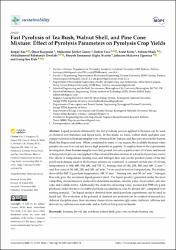| dc.contributor.author | Kar, Turgay | |
| dc.contributor.author | Kaygusuz, Ömer | |
| dc.contributor.author | Güney, Mükrimin Şevket | |
| dc.contributor.author | Cüce, Erdem Cüce | |
| dc.contributor.author | Keleş, Sedat | |
| dc.contributor.author | Shaik, Saboor | |
| dc.contributor.author | Owolabi, Abdulhameed Babatunde | |
| dc.contributor.author | Nsafon, Benyoh Emmanuel Kigha | |
| dc.contributor.author | Ogunsua, Johnson Makinwa | |
| dc.contributor.author | Huh, Jeung-Soo | |
| dc.date.accessioned | 2023-11-01T06:25:07Z | |
| dc.date.available | 2023-11-01T06:25:07Z | |
| dc.date.issued | 2023 | en_US |
| dc.identifier.citation | Kar, T., Kaygusuz, Ö., Güney, M.S., Cüce, E., Keleş, S., Shaik, S., Owolabi, A.B., Nsafon, B.E.K., Ogunsua, J.M. & Huh, J.S. (2023). Fast Pyrolysis of Tea Bush, Walnut Shell, and Pine Cone Mixture: Effect of Pyrolysis Parameters on Pyrolysis Crop Yields. Sustainability, 15818), 13718. https://doi.org/10.3390/su151813718 | en_US |
| dc.identifier.issn | 2071-1050 | |
| dc.identifier.uri | https://doi.org/10.3390/su151813718 | |
| dc.identifier.uri | https://hdl.handle.net/11436/8612 | |
| dc.description.abstract | Liquid products obtained by the fast pyrolysis process applied to biomass can be used as chemical raw materials and liquid fuels. In this study, tea bush, walnut shell, and pine cone samples selected as biomass samples were obtained from Trabzon and Rize provinces in the Eastern Black Sea Region and used. When considered in terms of our region, the available biomass waste samples are easy to access and have a high potential in quantity. To employ them in the experimental investigation, these biomass samples were first ground, sieved to a particle size of 1.0 mm, and mixed. A fast pyrolysis process was applied to this obtained biomass mixture in a fixed-bed pyrolysis reactor. The effects of temperature, heating rate, and nitrogen flow rate on the product yields of the fast pyrolysis technique used on the biomass mixture are examined. A constant particle size of 1.0 mm, temperatures of 300, 400, 500, 600, and 750 degrees C, heating rates of 100, 250, 400, and 600 degrees C.min-1, and flow rates of 50, 100, 200, and 300 cm3.min-1 were used in tests on fast pyrolysis. The studies showed the 500 degrees C pyrolysis temperature, 100 degrees C min-1 heating rate, and 50 cm3.min-1 nitrogen flow rate gave the maximum liquid product yield. The liquid product generated under the most compelling circumstances is analyzed to determine moisture, calorific value, fixed carbon, ash, raw coke, and volatile matter. Additionally, the crude bio-oil heating value, measured at 5900 cal/g and produced under the most favorable pyrolysis circumstances, rose by around 40% compared to its starting material. The liquid product obtained from rapid pyrolysis experiments can be used as liquid fuel. The evaluation of the potential of chemical raw materials can be a subject of research in a different discipline since there are many chemical raw materials (glycerine, furfurals, cellulose and derivatives, carbonaceous materials, and so forth) in fast pyrolysis liquids. | en_US |
| dc.language.iso | eng | en_US |
| dc.publisher | MDPI | en_US |
| dc.rights | info:eu-repo/semantics/openAccess | en_US |
| dc.subject | Biomass | en_US |
| dc.subject | Bio-oil | en_US |
| dc.subject | Fast pyrolysis | en_US |
| dc.subject | Walnut shell | en_US |
| dc.subject | Pine cone | en_US |
| dc.subject | Tea bush | en_US |
| dc.subject | Heating rate | en_US |
| dc.title | Fast pyrolysis of tea bush, walnut shell, and pine cone mixture: Effect of pyrolysis parameters on pyrolysis crop yields | en_US |
| dc.type | article | en_US |
| dc.contributor.department | RTEÜ, Mühendislik ve Mimarlık Fakültesi, Makine Mühendisliği Bölümü | en_US |
| dc.contributor.institutionauthor | Cüce, Erdem | |
| dc.identifier.doi | 10.3390/su151813718 | en_US |
| dc.identifier.volume | 15 | en_US |
| dc.identifier.issue | 18 | en_US |
| dc.identifier.startpage | 13718 | en_US |
| dc.relation.journal | Sustainability | en_US |
| dc.relation.publicationcategory | Makale - Uluslararası Hakemli Dergi - Kurum Öğretim Elemanı | en_US |


















